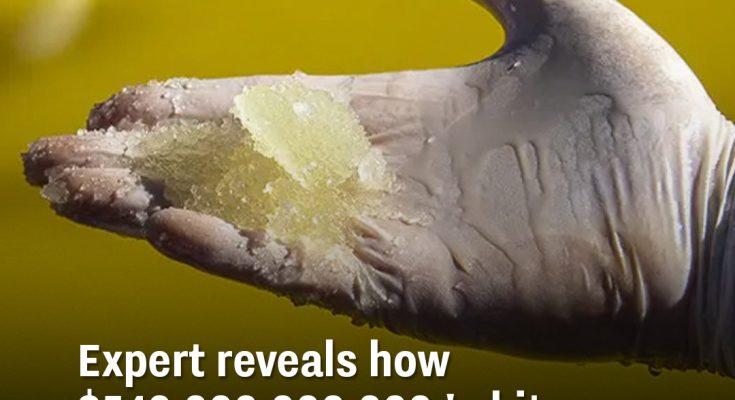A study of a US lake uncovered around 18 million tons of lithium, which is worth a whopping $540 billion.
It’s thought that the fortune is sitting at the bottom of Salton Sea in California.

Some 18 million tons of lithium are thought to be in Salton Sea (Allen J. Schaben / Los Angeles Times via Getty Images)
Lithium is commonly used in mobile phone batteries, laptops and electric cars.
It’s also found in things like pacemakers, toys and even clocks.
The amount found in California would be enough to power over 382 million electric cars.
Michael McKibben, who is one of the study’s authors and a geochemistry professor at the University of California, said: “This is one of the largest lithium brine deposits in the world.
“This could make the United States completely self-sufficient in lithium and stop importing it through China.”
If this was to happen, it’d have a major impact on the economy.

Lithium is used to create rechargeable EV batteries (Robert Alexander/Getty Images)
This is largely due to the fact that China is currently the second-biggest exporter of electric vehicles (EV), behind Germany.
According to Tendata, China was responsible for 22.7% of the world’s EV exports, worth a huge $34.1 billion.
The US was further down the table as the sixth-largest, exporting just 4.8%, worth $7.26 billion.
However, EV imports to the US from China increased from $7.2 million to $388.8 million between 2018 to 23, according to the US Trade Commission.
So it could be a pretty big blow to China if the US was no longer importing their EVs.
And the US would then be exporting more of its own EVs too, which would have a knock-on effect on the rest of the big exporters.
As of 2023, China has the largest market share of EVs at 37% of all new cars, while Europe is second with 24 percent and the US in third with 9.5%.
The US could increase their exports and their market share, making them more money and establishing themselves as EV leaders – something Elon Musk would certainly be celebrating.
And work has already begun on lithium extraction from Salton Sea .
In January, construction of the first large-scale direct lithium extraction plant near the lake began, the first of seven planned phases for the $1.85 billion facility, as per ENR California.
A team of researchers uncovered a field of dense manganese nodules on the seabed around 1,200 miles away from Tokyo, Japan.
The survey was conducted by The Nippon Foundation and the University of Tokyo, where they uncovered the nodules which contain millions of metric tons of cobalt and nickel.

An expert has revealed the devastating environmental impact (The Nippon Foundation)
These materials are vital in creating things like batteries for electric vehicles, making the discovery a gold mine.
According to market figures from Trading Economics, just one metric ton of cobalt is worth $24,300 and nickel has a value of $15,497.
The country has been able to unearth a whopping $14,823,000,000 worth of cobalt and the 740,000 tonnes of nickel is worth $11,467,780,000.
At the time of writing this, the value of the materials totals a colossal $26,290,780,000.
However, while deep-sea mining may be a massive money earner for Japan, a study has now issued a stern warning.
The excavations of the materials is actually killing the marine life.
The study conducted by Travis Washburn, a researcher at the Geological Survey of Japan, found that ocean creatures tend to vanish from areas within and even outside deep-sea mining operations.
“These results suggest the impact of deep-sea mining could be even bigger than we think,” Washburn said.
One year after the test was conducted, those working on the study found a massive 43 percent drop in fish and shrimp populations around the site.

Japan has hit the jackpot with its latest discovery (The Nippon Foundation)
“I had assumed we wouldn’t see any changes because the mining test was so small. They drove the machine for two hours, and the sediment plume only traveled a few hundred meters,” Washburn added.
“But it was actually enough to shift things.”
Meanwhile, Colin Hamilton spoke about the complexity mining at such depths provides.
“Extraction will not be simple, and we see this as a potential test case for the benefits versus disadvantages of deep-sea mining of materials relating to the global fuel to materials transition,” he noted in a recent brief.
Sophie Benbow, director of a marine programme at a conservation charity, told the BBC: “There is so much we could learn from ocean biodiversity.
“Medical advances and new technologies could be deciphered from the study of deep-sea species, but they could be wiped out before we even know they exist if deep-seabed mining is to go ahead prematurely.”

It seems to be the time for rare materials as what’s being called a modern day gold rush in Wyoming joins Ramaco Resources’ mine in providing America with two unlikely rare-Earth material deposits worth a staggering amount of money.
Currently around 95% of the world’s rare-Earth materials are sourced from China, so the discovery of sources this significant outside of the region is a significant boost to both economy and production for the host countries.
The reason why these materials are so valuable is due to their use in the production of lithium-ion batteries – specifically in technology like smartphones, hybrid cars, and aircrafts.
That’s why the discovery of rare minerals around the Minami-Tori-shima island harbors by Japanese researchers is so significant, as it not only gives the country a huge financial boost but also enhances their technical production too.

These manganese nodules have been found all across the sea floor (The Nippon Foundation)
Researchers conducted a survey of over 100 seabed sites, at depths of up to 5,200 meters, and they found quite the treasure trove.
As reported by the Nippon Foundation, it’s estimated that the surveyed area holds a dense field of 230 million tons of “easily extractable manganese deposits,” spread across an area of around 10,000km².
This includes 610,000 tons of cobalt and 740,000 tons of nickel – enough to meet Japans demands for 75 and 11 years respectively.
At the time of writing one metric ton of cobalt sells for $24,080, whereas the same amount of nickel will net you $15,288.
Therefore, if Japan was to sell the entire estimated find it would raise just over $26 billion, which would be quite the boost to the economy. However, as Japan currently imports almost all of their rare-Earth materials, it’s understood that they’d want to keep most of this crop in-house.

The discovery of the rare-Earth materials could boost Japan’s economy and production significantly (The Nippon Foundation)
It’s estimated that demands for materials like this will increase by 400 to 600% as battery-powered technology becomes the primary focus, replacing formerly gas and oil-powered industries.
Companies like Tesla have already seen a big boom in the US with their electric car production, but this could prove to be a significant boost for Japanese-based companies.
According to Yasuhiro Kato, a professor specializing in resource geology at the University of Tokyo, Japan plan to lift around three million tons of the sourced materials annually, while the University itself will provide detailed analysis of the extracted resources.
This limited yearly extraction is essential too as it minimizes the impact on the marine environment, as hunts for coal in other ocean areas have proven to be a destructive risk.
It’s been long established that plants and photosynthesizing plankton use energy from the sun to create underwater oxygen.
However new research claims that oxygen can actually be produced in areas of pure darkness with no light.
Last week, a new study entitled Evidence of dark oxygen production at the abyssal seafloor was published in the popular Nature Geoscience journal.
The research team, led by Professor Andrew Sweetman of the Scottish Association for Marine Science, initially made the discovery whilst assessing the Clarion-Clipperton Zone seabed for possible impacts of deep-sea mining.
Researchers began by surveying polymetallic nodules extracted from around 4,000 metres below the Pacific Ocean.

Polymetallic nodules produce dark oxygen. (Camille Bridgewater/Northwestern University)
They were surprised to discover that these potato-sized metallic deposits were carrying a ‘very high electric charge’ which could lead to the splitting of seawater into hydrogen and oxygen.
This process is commonly referred to as seawater electrolysis and Sweetman and his team recorded readings of up to 0.95 volts on the surfaces of some nodules.
They deduced that when the nodules were grouped together, they produced significant voltages.
As these deposits were releasing oxygen in complete darkness without help from living organisms, the finding challenges everything we know about how oxygen and thus how life is created on Earth.
“When we first got this data, we thought the sensors were faulty because every study ever done in the deep sea has only seen oxygen being consumed rather than produced,” admitted Professor Sweetman.
“We would come home and recalibrate the sensors, but, over the course of 10 years, these strange oxygen readings kept showing up.”
.jpg)
Dark oxygen was found in the Clarion-Clipperton Zone. (Craig Smith and Diva Amon, ABYSSLINE Project)
The team have since dubbed this bizarre finding as ‘dark oxygen’ and claims that the discovery has generated ‘many unanswered questions’.
“We now know that there is oxygen produced in the deep sea, where there is no light,” continued the study lead.
“I think we therefore need to revisit questions like: where could aerobic life have begun?”
According to SAMS Director Professor Nicholas Owens, the research will force scientists to ‘rethink how the evolution of complex life on the planet might have originated.’
“The conventional view is that oxygen was first produced around three billion years ago by ancient microbes called cyanobacteria and there was a gradual development of complex life thereafter,” he continued.

Polymetallic nodules were found on the seabed. (CCZ/NOAA Office of Ocean Exploration and Research, 2019 Southeastern U.S. Deep-sea Exploration)
“The potential that there was an alternative source requires us to have a radical rethink.”
Will dark oxygen stop mining in the Clarion-Clipperton Zone? Probably not.
However, it could help to inform experts on how to mine in the most environmentally friendly way possible.
Professor Sweetman added that the dark oxygen find needs to be explored in ‘greater detail’ and that they need to ‘use this information and the data we gather in future if we are going to go into the deep ocean’.
The sinkhole is located in southwestern China and is one of 30 holes known as “tiankeng” which translates to “heavenly pits”.
That’s because in China, instead of people being afraid of sinkholes, they consider them to be “heavenly”.
.webp)
The sinkhole is home to an ancient forest (X/@CGTNOfficial)
It’s a far cry from other parts of the world, where sinkholes gain eerie nicknames such as “Doorway to Hell”.
This most recent discovery in China was made in August last year where researchers found it to be containing pristine ancient forests and are likely to have species of small animals that have been previously unknown.
The hole itself is around 1,000 feet in length, 500 feet in width and over 630 feet in depth.
Because of how deep these sinkholes are, little light reaches the bottom but despite this, they are able to house a lot of greenery.

Sinkholes can provide a haven for plants to thrive (Nigel Killeen/Getty)
In fact, the recent sinkhole discovered is home to an underground forest completely unexplored by humans.
There are 130 feet tall trees and plants that date back to the time of the dinosaurs.
A new study has revealed just how these plants are able to survive as researches found nettles, ferns and other species living off stocks of nitrogen, phosphorus, potassium, calcium and magnesium.
The study’s authors wrote: “Plants can adapt to adverse environments by adjusting their nutrient content.

The sinkhole was found in the Karst landscape in China (Costfoto/NurPhoto via Getty Images)
“Due to the towering cliffs and steep terrain of the tiankeng, it has been less disturbed by human activities.”
In a piece for The UNESCO Courier, researcher Tang Jianmin said: “Karst tiankeng is a relatively closed environment with high humidity, low temperature and a high concentration of negative oxygen ions.
“Its bottom is connected with underground water flow, nurturing a lush green oasis all year round.
“Primitive ecosystems with unique animal, plant and microbial resources are formed there.”
Only 300 tiankeng have been found around the world and two thirds have been uncovered in China alone.

The sinkhole found is 630 feet deep (Eastimages/Getty Images)
Other places where these sinkholes have been discovered include Papua New Guinea, Malaysia and Madagascar, Slovenia, Croatia, Italy and Spain.
Explaining the importance of the holes, Jianmin continued, detailing how they are a “refuge for endangered plants and primitive forest ecosystems.
“There is also a good chance that previously unknown species will be discovered in these environments.”
They offer ancient forests a safe haven to continue to thrive.






